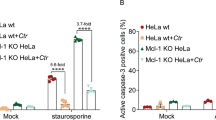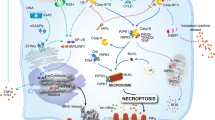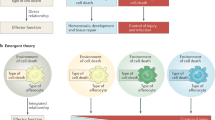Key Points
-
The chlamydiae are important obligate intracellular prokaryotic pathogens that replicate in cytoplasmic vesicles in a variety of different eukaryotic host cells, including the mucosal and vascular epithelia, smooth muscle cells, monocytes and macrophages.
-
A key pathogenic strategy of the chlamydiae is the ability to induce host-cell apoptosis under some circumstances and actively inhibit apoptosis under others. This flexible strategy is crucial for the pathogenic success of the chlamydiae as these organisms cause diseases in many different species and in many different host cell types, and a pro-apoptotic response in one host species or cell might not be appropriate in another host species or cell type. Also, the intracellular growth cycle of the chlamydiae is complex and can be productive or non-productive under different growth conditions and the growth status of the bacteria might affect their apoptotic activity.
-
Chlamydia-mediated protection against apoptosis occurs via a variety of different mechanisms. It is thought that Chlamydia trachomatis and Chlamydia pneumoniae can protect infected cells by inhibiting the release of cytochrome c from mitochondria. These chlamydial species also upregulate the expression of the anti-apoptotic mediators IAP and MCL-1. C. pneumoniae infection of monocytes also activates the transcription of NF-κB, although how this transcription factor contributes to the inhibition of apoptosis is still unclear. Protection against apoptosis may be a strategy that the chlamydiae use to maintain a persistent, chronic infection.
-
Chlamydia induction of host cell death has been a recognised phenomenon for more than 30 years, but the mechanisms of this cytotoxicity have only recently begun to be explored. Again, it is likely that different chlamydial species or biovars use different mechanisms and that the same species could use different mechanisms in different host species or cell types. Recent studies have shown that this apoptosis may be caspase independent. A chlamydial protein known as CADD — Chlamydia protein associating with death receptors — was recently identified and it has been suggested that CADD inhibits Fas-mediated apoptosis or induces cell death under different conditions.
Abstract
The chlamydiae are important obligate intracellular prokaryotic pathogens that, each year, are responsible for millions of human infections involving the eye, genital tract, respiratory tract, vasculature and joints. The chlamydiae grow in cytoplasmic vesicles in susceptible host cells, which include the mucosal epithelium, vascular endothelium, smooth muscle cells, circulating monocytes and recruited or tissue-specific macrophages. One important pathogenic strategy that chlamydiae have evolved to promote their survival is the modulation of programmed cell death pathways in infected host cells. The chlamydiae can elicit the induction of host cell death, or apoptosis, under some circumstances and actively inhibit apoptosis under others. This subtle pathogenic mechanism highlights the manner in which these highly successful pathogens take control of infected cells to promote their own survival — even under the most adverse circumstances.
This is a preview of subscription content, access via your institution
Access options
Subscribe to this journal
Receive 12 print issues and online access
$209.00 per year
only $17.42 per issue
Buy this article
- Purchase on SpringerLink
- Instant access to full article PDF
Prices may be subject to local taxes which are calculated during checkout


Similar content being viewed by others
References
Danial, N. N. & Korsmeyer, S. J. Cell death: critical control points. Cell 116, 205–219 (2004).
Bloss, T. A., Witze, E. S. & Rothman, J. H. Suppression of CED-3-independent apoptosis by mitochondrial β-NAC in Caenorhabditis elegans. Nature 424, 1066–1071 (2003).
Brennecke, J., Hipfner, D. R., Stark, A., Russell, R. B. & Cohen, S. M. Bantam encodes a developmentally regulated microRNA that controls cell proliferation and regulates the proapoptotic gene hid in Drosophila. Cell 113, 25–36 (2003).
Lindsten, T. et al. The combined functions of pro-apoptotic Bcl-2 family members bak and bax are essential for normal development of multiple tissues. Mol. Cell 6, 1389–1399 (2000).
Juo, P., Kuo, C. J., Yuan, J. & Blenis, J. Essential requirement for caspase-8/FLICE in the initiation of the Fas-induced apoptotic cascade. Curr. Biol. 8, 1001–1008 (1998).
Wallach, D. et al. Tumor necrosis factor receptor and Fas signaling mechanisms. Annu. Rev. Immunol. 17, 331–367 (1999).
Savill, J. & Fadok, V. Corpse clearance defines the meaning of cell death. Nature 407, 784–788 (2000).
Fadok, V. A. et al. Macrophages that have ingested apoptotic cells in vitro inhibit proinflammatory cytokine production through autocrine/paracrine mechanisms involving TGF-β, PGE2, and PAF. J. Clin. Invest. 101, 890–898 (1998).
Huynh, M. -L., Fadok, V. A. & Henson, P. M. Phosphatidylserine-dependent ingestion of apoptotic cells promotes TGF-β1 secretion and the resolution of inflammation. J. Clin. Invest. 109, 41–50 (2002).
Gallucci, S. & Matzinger, P. Danger signals: SOS to the immune system. Curr. Opin. Immunol. 13, 114–119 (2001).
Matzinger, P. The danger model: a renewed sense of self. Science 296, 301–305 (2002).
Di Virgilio, F. et al. Nucleotide receptors: an emerging family of regulatory molecules in blood cells. Blood 97, 587–600 (2001).
Müller, S. et al. The double life of HMGB1 chromatin protein: architectural factor and extracellular signal. EMBO J. 16, 4337–4340 (2001).
Shi, Y., Evans, J. E. & Rock, K. L. Molecular identification of a danger signal that alerts the immune system to dying cells. Nature 425, 516–521 (2003).
Coutinho-Silva, R. et al. Inhibition of chlamydial infectious activity due to P2X7 receptor-dependent phospholipase D activation. Immunity 19, 403–412 (2003).
Kusner, D. J. & Barton, J. A. ATP stimulates human macrophages to kill intracellular virulent Mycobacterium tuberculosis via calcium-dependent phagosome–lysosome fusion. J. Immunol. 167, 3308–3315 (2001).
Lammas, D. A. et al. ATP-induced killing of mycobacteria by human macrophages is mediated by purinergic P2Z(P2X7) receptors. Immunity 7, 433–444 (1997).
Takaoka, A. et al. Integration of interferon-α/β signalling to p53 responses in tumour suppression and antiviral defence. Nature 424, 516–523 (2003).
Everett, H. & McFadden, G. Apoptosis: an innate immune response to virus infection. Trends Microbiol. 7, 160–165 (1999).
Kaplan, D. & Sieg, S. Role of Fas/Fas ligand apoptotic pathway in human immunodeficiency virus type I disease. J. Virol. 72, 6279–6282 (1998).
Evan, G. & Littlewood, T. A matter of life and cell death. Science 281, 1317–1322 (1998).
Weinrauch, Y. & Zychlinsky, A. The induction of apoptosis by bacterial pathogens. Annu. Rev. Microbiol. 53, 155–187 (1999).
Galmiche, A. et al. The N-terminal 34-kDa fragment of Helicobacter pylori vacuolating cytotoxin targets mitochondria and induces cytochrome c release. EMBO J. 19, 6361–6370 (2000).
Zychlinsky, A., Prevost, M. C. & Sansonetti, P. J. Shigella flexneri induces apoptosis in infected macrophages. Nature 358, 167–169 (1992).
Mills, S. D. et al. Yersinia enterocolitica induces apoptosis in macrophages by a process requiring functional type III secretion and translocation mechanisms and involving YopP, presumably acting as an effector protein. Proc. Natl Acad. Sci. USA 94, 12638–12643 (1997).
Clifton, D. R. et al. NF-κB-dependent inhibition of apoptosis is essential for host cell survival during Rickettsia rickettsii infection. Proc. Natl Acad. Sci. USA 85, 4641–4651 (1998).
Dean, D. & Powers, V. C. Persistent Chlamydia trachomatis infections resist apoptotic stimuli. Infect. Immun. 69, 2442–2447 (2001). The first data to indicate that protection against apoptosis might be related to the ability of a host cell to maintain persistent chlamydial infection.
Fan, T. et al. Inhibition of apoptosis in Chlamydia-infected cells: blockade of mitochondrial cytochrome c release and caspase activation. J. Exp. Med. 187, 487–496 (1998). The first demonstration that cells infected with C. trachomatis are resistant to apoptosis mediated by external inducers of apoptosis.
Fischer, S. F., Harlander, T., Vier, J. & Hacker, G. Protection against CD95-induced apoptosis by chlamydial infection at a mitochondrial step. Infect. Immun. 72, 1107–1115 (2004). This elegant study shows that Chlamydia -infected cells are resistant to mitochondrion-dependent apoptosis, but are sensitive to death if apoptosis does not require a mitochondrial step.
Fischer, S. F., Schwarz, C., Vier, J. & Hacker, G. Characterization of anti-apoptotic activities of Chlamydia pneumoniae in human cells. Infect. Immun. 69, 7121–7129 (2001).
Rajalingam, K. et al. Epithelial cells infected with Chlamydophila pneumoniae (Chlamydia pneumoniae) are resistant to apoptosis. Infect. Immun. 69, 7880–7888 (2001).
Greene, W., Xiao, Y., Huang, Y., McClarty, G. & Zhong, G. Chlamydia-infected cells continue to undergo mitosis and resist induction of apoptosis. Infect. Immun. 72, 451–460 (2004).
Wahl, C. et al. Survival of Chlamydia pneumoniae-infected Mono Mac 6 cells is dependent on NF-κB binding activity. Infect. Immun. 69, 7039–7045 (2001).
Karin, M. & Lin, A. NF-κB at the crossroads of life and death. Nature Immunol. 3, 221–227 (2002).
Hess, S. et al. More than just innate immunity: comparative analysis of Chlamydophila pneumoniae and Chlamydia trachomatis effects on host-cell gene regulation. Cell. Microbiol. 5, 785–795 (2003).
Hess, S. et al. The reprogrammed host: Chlamydia trachomatis-induced upregulation of glycoprotein 130 cytokines, transcription factors, and anti-apoptotic genes. Arthritis Rheum. 44, 2392–2401 (2001).
Xia, M., Bumagarner, R. E., Lampe, M. F. & Stamm, W. E. Chlamydia trachomatis infection alters host cell transcription in diverse cellular pathways. J. Infect. Dis. 187, 424–434 (2003).
Beatty, W. L., Byrne, G. I. & Morrison, R. P. Morphologic and antigenic characterization of interferon-γ-mediated persistent Chlamydia trachomatis infection in vitro. Proc. Natl Acad. Sci. USA 90, 3998–4002 (1993). An original elaboration of how persistent chlamydial growth is linked to chronic disease pathogenesis.
Hogan, R. J., Mathews, S. A., Mukhopadhyay, S., Summersgill, J. T. & Timms, P. Chlamydial persistence: beyond the biphasic paradigm. Infect. Immun. 72, 1843–1855 (2004).
Chang, G. T. & Moulder, J. W. Loss of inorganic ions from host cells infected with Chlamydia psittaci. Infect. Immun. 19, 827–832 (1978).
Friis, R. R. Interaction of L cells and Chlamydia psittaci: entry of the parasite and host responses to its development. J. Bacteriol. 180, 706–721 (1972). A classic ultrastructural description of the nature of the chlamydial inclusion.
Fudyk, T., Olinger, L. & Stephens, R. S. Selection of mutant cell lines resistant to infection by Chlamydia trachomatis and Chlamydia pneumoniae. Infect. Immun. 70, 6446–6447 (2002).
Todd, W. J. & Storz, J. Ultrastructural cytochemical evidence for the activation of lysosomes in the cytocidal effect of Chlamydia psittaci. Infect. Immun. 12, 638–646 (1975).
Wyrick, P. B., Brownridge, E. A. & Ivins, B. E. Interaction of Chlamydia psittaci with mouse peritoneal macrophages. Infect. Immun. 19, 1061–1067 (1978).
McCoy, A. J., Sandlin, R. C. & Maurelli, A. T. In vitro and in vivo functional activity of Chlamydia MurA, a UDP-N-acetylglucosamine enolpyruvyl transferase involved in peptidoglycan synthesis and fosfomycin resistance. J. Bacteriol. 185, 1218–1228 (2003).
Gibellini, D., Panaya, R. & Rumpianesi, F. Induction of apoptosis by Chlamydia psittaci and Chlamydia trachomatis infection in tissue culture cells. Zentralblatt für Bakteriologie 288, 35–43 (1998).
Ojcius, D. M., Souque, P., Perfettini, J. L. & Dautry-Varsat, A. Apoptosis of epithelial cells and macrophages due to infection with the obligate intracellular pathogen Chlamydia psittaci. J. Immunol. 161, 4220–4226 (1998).
Perfettini, J. -L. et al. Effect of Chlamydia trachomatis infection and subsequent TNF-α secretion on apoptosis in the murine genital tract. Infect. Immun. 68, 2237–2244 (2000).
Perfettini, J. L. et al. Role of Bcl-2 family members in caspase-independent apoptosis during Chlamydia infection. Infect. Immun. 70, 55–61 (2002).
Jäättelä, M. & Tschopp, J. Caspase-independent cell death in T lymphocytes. Nature Immunol. 4, 416–423 (2003).
Leist, M. & Jäättelä, M. Four deaths and a funeral: from caspses to alternative mechanisms. Nature Rev. Mol. Cell Biol. 2, 589–598 (2001).
Lorenzo, H. K., Susin, S. A., Penninger, J. M. & Kroemer, G. Apoptosis inducing factor (AIF): a phylogenetically old, caspase-independent effector of cell death. Cell Death Differ. 6, 516–524 (1999).
Pastorino, J. G., Chen, S. T., Tafani, M., Snyder, J. W. & Farber, J. L. The overexpression of Bax produces cell death upon induction of the mitochondrial permeability transition. J. Biol. Chem. 273, 7770–7775 (1998).
Xiang, J., Chao, D. T. & Korsmeyer, S. J. BAX-induced cell death may not require interleukin 1β-converting enzyme-like proteases. Proc. Natl Acad. Sci. USA 93, 14559–14563 (1996).
Azenabor, A. A. & Mahony, J. B. Generation of reactive oxygen species and formation of membrane lipid peroxides in cells infected with Chlamydia trachomatis. Int. J. Infect. Dis. 4, 46–50 (1999).
Hatch, G. M. & McClarty, G. Cardiolipin remodeling in eukaryotic cells infected with Chlamydia trachomatis is linked to elevated mitochondrial metabolism. Biochem. Biophys. Res. Commun. 243, 356–360 (1998).
Ojcius, D. M., Degani, H., Mispelter, J. & Dautry-Varsat, A. Enhancement of ATP levels and glucose metabolism during an infection of Chlamydia. J. Biol. Chem. 273, 7052–7058 (1998).
Perfettini, J. L. et al. Role of proapoptotic BAX in propagation of Chlamydia muridarum (the mouse pneumonitis strain of Chlamydia trachomatis) and the host inflammatory response. J. Biol. Chem. 278, 9496–9502 (2003). Demonstration that the efficiency of Chlamydia infection and pathology are linked to BAX activation in vaginally infected mice.
Belland, R. J. et al. Chlamydia trachomatis cytotoxicity associated with complete and partial cytotoxin genes. Proc. Natl Acad. Sci. USA 98, 13984–13989 (2001). Initial documentation of a chlamydial toxin, one of the few true virulence factors identified for this pathogen.
Jungas, T., Verbeke, P., Darville, T. & Ojcius, D. M. Cell death, BAX activation, and HMGB1 release during infection with Chlamydia. Microbes Infect. (in the press).
DeFilippis, R. A., Goodwin, E. C., Wu, L. & DiMaio, D. Endogenous human papillomavirus E6 and E7 proteins differentially regulate proliferation, senescence, and apoptosis in HeLa cervical carcinoma cells. J. Virol. 77, 1551–1563 (2003).
Stenner-Liewen, F. et al. CADD, a Chlamydia protein that interacts with death receptors. J. Biol. Chem. 277, 9633–9636 (2002). First identification of a chlamydial mediator that modulates apoptosis.
Schwarzenbacher, R. et al. Structure of the Chlamydia protein CADD reveals a redox enzyme that modulates host cell apoptosis. J. Biol. Chem. 279, 29320–29324 (2004).
Su, H. et al. Activation of Raf/MEK/ERK/cPLA2 signaling pathway is essential for chlamydial acquisition of host glycerophospholipids. J. Biol. Chem. 279, 9409–9416 (2004).
Slepenkin, A., Motin, V., de la Maza, L. M. & Peterson, E. M. Temporal expression of type III secretion genes of Chlamydia pneumoniae. Infect. Immun. 71, 2555–2562 (2003).
Gavrilescu, L. C. & Denkers, E. Y. Apoptosis and the balance of homeostatic and pathologic responses to protozoan infection. Infect. Immun. 71, 6109–6115 (2003).
Thornberry, N. A. & Lazebnik, Y. Caspases: enemies within. Science 281, 1312–1316 (1998).
Messmer, U. K. & Pfeilschifter, J. New insights into the mechanism for clearance of apoptotic cells. Bioessays 22, 878–881 (2000).
Martinou, J. -C. & Green, D. R. Breaking the mitochondrial barrier. Nature Rev. Mol. Cell Biol. 2, 63–67 (2001).
Jungas, T. et al. Glutathione levels and BAX activation during apoptosis due to oxidative stress in cells expressing wild-type and mutant cystic fibrosis transmembrane conductance regulator. J. Biol. Chem. 277, 27912–27918 (2002).
Khaled, A. R., Kim, K., Hofmeister, R., Muegge, K. & Durum, S. K. Withdrawal of IL-7 induces Bax translocation from cytosol to mitochondria through a rise in intracellular pH. Proc. Natl Acad. Sci. USA 96, 14476–14481 (1999).
Matsuyama, S., Llopis, J., Deveraux, Q. L., Tsien, R. Y. & Reed, J. C. Changes in intramitochondrial and cytosolic pH: early events that modulate caspase activation during apoptosis. Nature Cell Biol. 2, 318–325 (2000).
Belland, R. J., Ojcius, D. M. & Byrne, G. I. Disease watch focus: Chlamydia. Nature Rev. Microbiol. 2, 530–531 (2004).
Campbell, L. A. & Kuo, C. C. Chlamydia pneumoniae — an infectious risk factor for atherosclerosis? Nature Rev. Microbiol. 2, 23–32 (2004).
Byrne, G. I. Chlamydia uncloaked. Proc. Natl Acad. Sci. USA 100, 8040–8042 (2003).
Perfettini, J. L. et al. Cell death and inflammation during infection with the obligate intracellular pathogen. Chlamydia. Biochimie 85, 763–769 (2003).
Fischer, S. F. et al. Chlamydia inhibit host-cell apoptosis by degradation of pro-apoptotic BH3-only proteins. J. Exp. Med. (in the press).
Acknowledgements
Work in the authors' laboratories is supported by grants from the Public Health Service. We thank O. S. Mahdi for her help in organizing and critiquing the manuscript.
Author information
Authors and Affiliations
Corresponding author
Ethics declarations
Competing interests
The authors declare no competing financial interests.
Related links
Related links
DATABASES
Entrez
SwissProt
FURTHER INFORMATION
Glossary
- APOPTOSIS
-
A form of cell death, also known as programmed cell death, which is typically characterized by death receptor ligand or mitochondria-elicited activation of caspase proteases and which leads to nuclear condensation, DNA fragmentation and clearance of the dead cell by surrounding tissue.
- CASPASES
-
Family of cytosolic proteases that contain a cysteine residue within the active site, and which cleave their substrate after an aspartic acid residue. They can be divided into inflammatory caspases, which cleave and activate pro-inflammatory cytokines, and pro-apoptotic caspases, which cleave and activate pro-apoptotic substrates.
- NECROSIS
-
An accidental cell death process that is characterized by an accompanying inflammatory response.
- PURINERGIC RECEPTORS
-
A family of receptors that are stimulated by the purine nucleotides — ATP, ADP, AMP and UTP.
- TYPE I CELLS
-
Cells that recruit caspase 8, which results in the subsequent cleavage of caspase 3.
- TYPE II CELLS
-
Cells that activate caspase 3 through a mitochondria-dependent step.
- BIOVARS
-
The phenotypical distinction of bacteria within the same species based on biological tests such as simple biochemical and/or enzymatic differences.
- APOPTOSOME PATHWAY
-
A pathway of caspase activation that requires release of cytochrome c from the mitochondria.
- PLAQUE ASSAY
-
An assay that allows visualization of the cytopathic effect of viruses or bacteria in a monolayer of host cells. The plaque centre lacks cells due to infection-induced lysis.
- BH3-ONLY PROTEINS
-
Proteins that contain a BCL-2 homology (BH) 3 domain, but not the other BH domains usually found in BCL-2 family proteins. The BH3 domain is required to inhibit the activity of pro-survival proteins related to BCL-2.
- CLOSTRIDIAL CYTOTOXIN HOMOLOGUES
-
Cytopathic toxins, found in many bacteria, which inactivate host-cell proteins that regulate actin polymerization, causing the cells to round up.
- DEATH DOMAIN
-
A region of limited homology consisting of about 80 residues close to the intracellular carboxyl terminus of some cell-membrane receptors that is essential for the receptors to generate a signal leading to apoptosis.
Rights and permissions
About this article
Cite this article
Byrne, G., Ojcius, D. Chlamydia and apoptosis: life and death decisions of an intracellular pathogen. Nat Rev Microbiol 2, 802–808 (2004). https://doi.org/10.1038/nrmicro1007
Issue Date:
DOI: https://doi.org/10.1038/nrmicro1007



